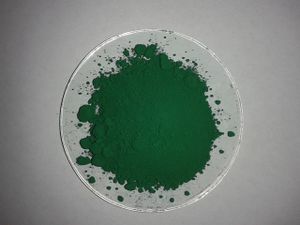Chromium(III) oxide
 |
This article is a stub. Please help Sciencemadness Wiki by expanding it, adding pictures, and improving existing text.
|
Chromium(III) oxide, also known as chrome green, chromia, or chromium sesquioxide is the inorganic compound with chemical formula Cr2O3.
Contents
Properties
Chemical
Chromium(III) oxide reacts with acids to form chromium(III) salts, though samples that have been heavily annealed at high temperature are not readily attacked by acids or bases. Molten alkalis react with chromium(III) oxide to form chromates or chromites. Chromium(III) oxide can be used to produce a low-energy thermite with aluminum or magnesium powder.
Physical
Chromium(III) oxide is a dark green powder and is slightly hygroscopic. It turns brown when heated, but reverts to its dark green color when cooled.
Availability
Chrome green is available at pottery shops as a green pigment, usually containing traces of calcium carbonate.This material, however, may be too unreactive to produce other chromium compounds.
Preparation
Chromium(III) oxide can be prepared by reducing potassium dichromate with sulfur:
- K2Cr2O7 + S → K2SO4 + Cr2O3
It can also be prepared from the thermal decomposition of ammonium dichromate:
- (NH4)2Cr2O7 → Cr2O3 + N2 + 4 H2O
or by reacting chromium trioxide with ethanol.
It is the most common byproduct of the reduction of chromium(VI) compounds, especially in neutral solution.
Projects
- Make chromium metal
- Make sodium chromate
Handling
Safety
Chromium(III) oxide is not extremely reactive. If ingested it may cause nausea, vomiting and diarrhea. As it stains, gloves and protective clothing should be worn.
Storage
Chromia doesn't require any special storage.
Disposal
While not as toxic as chromium(VI) compounds, it's best to avoid dumping it in the environment.
